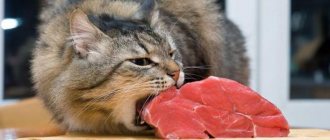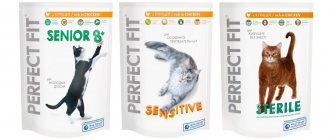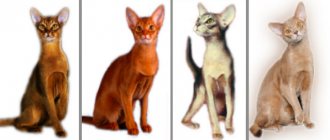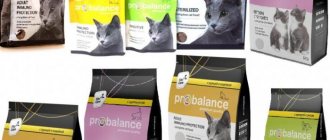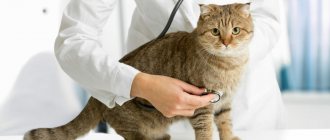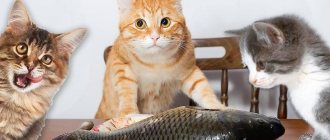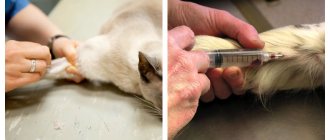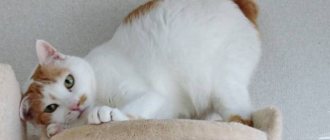Pros and cons of different types of feeding
It is possible to ensure the full functioning of Abyssinian cats by three types of feeding: - natural products; — ready-made dry and canned wet food; - in a combined way, including the previous paragraphs. You can make a choice in favor of one of the types and feed your pet correctly if you know about the characteristics of each of them.
What is included in a natural diet
The very definition of “natural food” evokes a positive response in people. Especially if you add “ecologically friendly nutrition”. When choosing this way to meet the needs of a purebred Abyssinian cat, you will have to learn about all the components of the cat’s, cat’s or kitten’s diet that the animal needs. After all, manufacturers add the necessary additives to ready-made food - this greatly simplifies the tasks of the owners of Abyssinian cats. In uncanned food, the necessary vitamins and microelements may be insufficient or in excess if the same type of food is given.
List of foods that should be given to an Abyssinian cat
A sufficient natural diet means the periodic, proportionally adjusted presence in the menu of the following foods: - dairy products; - cottage cheese (preferably goat's) and/or low-fat sour cream, fermented baked milk, yogurt, but not cow's milk; - boiled or raw (but always frozen!) meat in the form of minced meat or finely chopped product - rabbit, beef (but not veal), lamb are suitable; - boiled poultry (turkey, chicken (not breast); - liver and offal - also frozen, in no case pork; - eggs (eats only boiled yolk, preferably quail, 1-2 times a week); - fish (only sea, since river water contains parasites, as well as many small sharp bones) and fish oil; - a small amount of cereals, sometimes legumes (cooked, but not boiled, include rolled oats, rice, buckwheat, sprouted grains); - boiled or grated vegetables (carrots, zucchini, beets, broccoli, chopped in a blender or finely chopped); - vegetable oil (preferably olive or flaxseed, half a teaspoon every other day); - greens - special grass for cats.
Salt, and especially sugar, even in minute quantities, should be avoided in the Abyssinian cat’s food, and the ratio of products should be as follows: - meat or fish - 50%; — fermented milk, eggs and cereals — 40%; — vegetables plus herbs — 10%.
Permanent additives to natural food include: - brewer's yeast (dry, up to 4 times a week); - mixtures that include microelements and vitamins necessary for the Abyssinian cat. The owner of a mustachioed friend will have to keep a diary to maintain a varied diet and not overdo it with additives.
Rules for preparing natural food. Norms
In addition to the fact that you need to calculate what and how much to give your Abyssinian cat, it is important how to prepare and offer the food. The general rules are as follows: - always give fermented milk and meat (fish) products at different feedings; - always pour boiling water over it, but if possible do not subject it to heat treatment, which reduces the nutritional value of products such as meat, fish, vegetables; - offer meat with vegetables and herbs; — get used to unfamiliar food gradually, starting with a small amount, and observing whether allergy symptoms appear.
Natural food should be thick in consistency and served lukewarm to the cat - the animal does not eat hot!
Its norms are calculated using the formula: multiply the weight of the animal by 5, divide by 100. Ideally, an adult cat should quickly eat the given portion, leaving nothing “for later.”
Ready-made food for the Abyssinian cat breed
Choosing industrially produced food greatly simplifies the task of balanced nutrition. However, cheap offers from supermarkets, breeders believe, are cat poison. They destroy both the digestive and genitourinary systems, and are especially harmful during the growth period of the kitten. For a purebred animal, you need professional dry and wet food - “holistic”, “premium”, “super-premium”. They include natural meat, sometimes grains, vegetables or fruits, prebiotics (FOS, MOS), a set of vitamins, microelements (calcium, copper, phosphorus, etc.), amino acid (usually taurine).
Recommendations for choosing industrial feed
Having chosen a certain brand of ready-made food specifically for Abyssinian cats, it is better to stick to the choice or not change it suddenly. Different manufacturers, adhering to the composition as a whole, include their additives in food in their own proportions. A radical change in menu can have a negative impact on your pet's stomach. In addition, be sure to take into account: - age category of packaging - children's, junior, adult food, food for older cats; — targeting of food for the special condition of the animal: pregnancy, specific disease, tendency to obesity. You need to add dry or wet food exactly as much as recommended on the packaging or in the instructions, without giving in to your pet’s “persuasion” for more. It is very undesirable to completely abandon the share of the natural menu in the diet of an Abyssinian cat. For an adult Abyssinian or Abyssinian, especially neutered ones who are prone to overeating, overfeeding is more dangerous than mild hunger - obesity will lead to a number of different diseases.
Mixed feeding
The combined type of nutrition of an Abyssinian cat means a combination of natural food with industrially prepared food. This usually happens when the owner does not constantly cook for the Abyssinian due to lack of time, for example, on weekdays. In this case, it is important to introduce a system of alternating types of diet. Having become accustomed to not being given dry food on weekends, the cat will gradually stop begging for “tasty food” and limit itself to natural products. Mixed feeding is fraught with imbalance - the Abyssinian cat’s menu may contain too many or few of the necessary components. Therefore, in this case, the cat’s owner will also have to keep records. An Abyssinian cat should not need to drink - clean dishes and water changed daily should be kept close to the bed. The cat's dishes should not be left with dried food residues; the bowl should be washed after feeding.
Tray training
Abyssinians are very smart, so there should be no problems with litter box training. Typically, purebred kittens are transferred to a new owner at the age of 3 months. Until this time, they are raised by the breeder. It is he who teaches his animals the rules of behavior, including the ability to use a tray. The new owner can only show the kitten where the toilet is and make sure that the pet goes there for the first time.
Anyone who breeds Abyssinian cats will have to independently train small kittens to use the litter box. Mother cat helps with this. She uses her example to show kids where to go to the toilet. Sometimes there may be mistakes, but you need to be patient and put the naughty baby in the tray every time.
If your pet persists and cannot be trained, the following recommendation from experienced felinologists will help. You need to moisten a cloth with the kitten's urine and put it in the tray. The animal will smell itself and next time go to the toilet in the right place.
Features of feeding Abyssinian kittens
Abyssinian kittens have no problems with food in the first one and a half, or even two months of life - mother's milk is enough. Feed very carefully, in very small portions. Soft food can be offered at one and a half months of age. The number of feedings per day depends on age: - 6 times a day for 120-150 grams - up to 3 months using a children's assortment of ready-made food or natural boiled, pureed products (taking into account baby teeth); - 5 times - after three to five months - medium-hard food is added after the appearance of the second strong teeth; - 4, and soon 3 meals after 5 to 8 months from the “junior” line, and with natural feeding - very finely chopped. - Starting from 8 months of age, young animals, like adults, are invited “to the table” in the morning and evening.
Feeding an older cat
The diet of an elderly Abyssinian cat should be treated with special attention. With age, it has become less active, therefore, it requires fewer calories than its young relatives. Of course, vitamins and nutrients should be supplied in sufficient quantities, but weight gain due to less mobility will lead to dangerous obesity for domestic cats. When creating a complete, but not too high-calorie diet for an elderly pet, you need to take into account her ailments - after 12 years, all cats have them. The finished product lines contain special developments that are ideal for Abyssinian older cats. But in connection with a specific disease, a special veterinary diet may be needed, the composition of which is optimal for maintaining strength and a good quality of life for an older animal, be it a cat or a female cat.
Vitamins and mineral supplements to food in the diet of Abyssinian cats
The composition and volume of vitamins, minerals and trace elements must be selected individually, taking into account the age, size and health status of the Abyssinian cat. Standard food necessarily contains potassium, calcium and magnesium, yeast, Omega-3 polyunsaturated fatty acids and an arbitrary combination of vitamins. This is enough to maintain normal pet health.
If difficulties arise with the bones and muscles, skin and coat, immunity or gastrointestinal tract, it is recommended to seek veterinary help. The doctor will prescribe additional vitamin support for the cat or prescribe a separate medicinal food that contains the necessary nutritional supplements.
Algorithm for switching to a different type of diet
Sometimes a situation arises that forces you to radically change the usual menu of an Abyssinian cat - for example, a trip when it becomes impossible to provide the usual natural food. It is better to think about this in advance, a week in advance, and act according to the scheme of gradually weaning the Abyssinian from the previous food and getting used to the new food. Whether for a kitten or a big cat, it is as follows: 1-2 days of transition - the share of the usual food is 75%, the new one is 25%; Days 3-4 can be balanced 50 to 50%; 5-6 days – the share of new food is 75%. On the seventh day, if no problems are found in the form of allergies, indigestion or stool problems, you can offer 100% of the new menu.
If the Abyssinian cat’s well-being is not all right, you need to immediately return half of its usual dishes. The scheme also works when switching from one brand of ready-made food to another manufacturer - the pet’s digestive system may not like this.
What you should never give to cats
Neither kittens of any age nor adult cats should be offered: - poultry bones: sharp fragments can cause perforation of the stomach and intestines; - any type of pork - such meat immediately increases cholesterol; - fatty foods: the only fat may be a limited amount of vegetable oil; - river fish that has bones and parasites that do not die when cooked; — confectionery products of any kind; - fresh white bread, especially rich bread; - flour dishes - pancakes, pies, pasta; — marinades, pickles of any kind; - fried smoked food, any sausages. It is unacceptable to offer leftover dishes from the hosts’ table or stale food, as well as very liquid soups in large quantities.
About treats for cats
It is impossible not to pamper an Abyssinian who has become a pet with tasty treats. The special treats produced for cats are not food, but they add variety to the regular diet, which has a beneficial effect on the mood and health of the pet. Manufacturers add only natural ingredients (meat, cheese, fish) and healthy vitamins to all sorts of “mnyams” and “mur-r-meladas”. The treat can be either a dessert or a reward for completing a rule or trick, but in no way should it upset the overall nutritional balance. The negative aspects of pampering include: - getting used to tasty things and refusing regular food; - the risk of gaining excess weight due to the caloric content of products; - incompatibility with the main, especially dietary, type of feeding, leading to disorders. The main thing is to let your pet understand that a tasty morsel must be earned. Proper nutrition is the key to the health of Abyssinian cats. A frivolous attitude towards the animal's menu, random feeding without taking into account the needs will lead to problems. Their solution is much more difficult and expensive than caring for high-quality cat food. Remember that not caring about a good diet can bring your pet illness, suffering, and early death of the Abyssinian cat.
Read all about the Abyssinian breed in the Main article
Choosing a place and dishes
For a comfortable stay, Abyssinian cats need to equip a house for sleeping and relaxing. It is placed in a secluded place, where the kitten spends the most time. You cannot place a cat house near household heating appliances or in drafts.
Important! The choice of place and dishes depends largely on age and character. Individual characteristics of your pet.
As for bowls, a cat should have 2-3 bowls. Two are for food. One may be deeper and wider, the second with several compartments. The main thing is that the kitten’s whiskers do not rest against the sides during the meal. For water, choose a deeper bowl so that your pet can drink comfortably.
You can buy special bowls for kittens. But remember that animals grow quickly, so you can give food to a small pet from bowls for adult cats.
Bowls can be:
- made of durable plastic;
- ceramics, clay;
- stainless steel
Important! Do not use aluminum containers for feeding cats or drinking water. Aluminum releases harmful chemicals, especially when exposed to high temperatures.
Set up a place where your pet will eat. This should not be a pass-through place. If there are other animals in the house, place bowls on the nightstand, windowsill, or other elevated surfaces. No one should disturb the kitten while eating.
Place the water bowl further away from the food bowls. Residues of food should not get into drinking water. This is unsafe for the pet's health.
Keep your cat's dishes clean and rinse them with clean running water after each feeding without using household chemicals.


